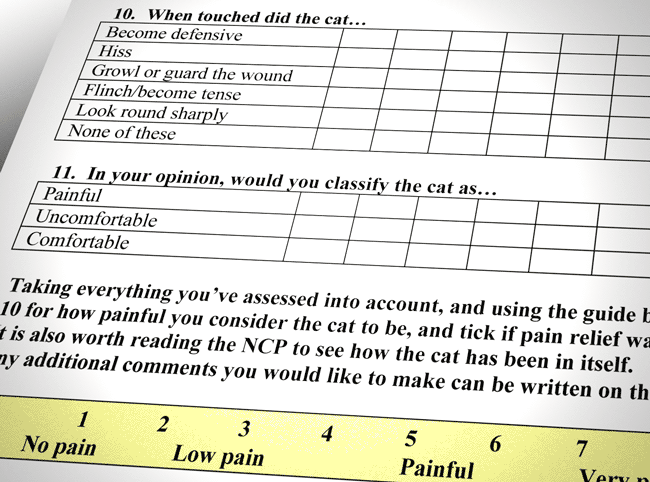I’ve been hearing a classic client phrase a little too much recently. I realise it can be difficult for some people to get – that animals feel physical pain just like we do – but when the evidence is staring you straight in the face (or even trying to bite your hand), why can people still not see it?

The phrase is: “She’s slowing down because she’s old.”
NO! NO! NO! Age is not a disease. How often can I say that? Slowing down is not a sign of age, it’s a sign of pain.
Calm, Jane. Calm…
The fifth vital sign
While we spend our days carefully pain scoring our patients using a pain evaluation chart, what can we do for our clients to help him or her improve their pet’s welfare?
We know pain increases healing time for wounds. It impacts negatively on the patients psychologically. It makes them harder to treat for other ailments. It’s so important in the human nursing sphere it is now classed as the fifth vital sign.
Clients are clearly monitoring their pets’ activity levels and are able to comment on a reduction in mobility. In passing, they will report a reluctance to take long walks, how they’re slow getting out of bed. They’ll mention the scratching post isn’t used much any more and they don’t want to jump on the sofa like they used to – these are all key pointers to a pet in pain.
So, how do we turn that information into help for the pet?
Many clients have not yet translated that as a need to see the vet and potentially start some form of treatment or extra care. Not every pet will need medication.
Mild pain: the holistic approach

An application of nursing care at home should be the first port of call for mild pain. A holistic approach is needed. Finding out where the bed is, where the food is and how is it served are key points.
The bed may need moving out of draughts and may need to be checked to see if it gives good support – most pet beds become a bit saggy after a few washes. A heat pad works wonders for pets with mild pain.
Food bowls on the floor can aggravate sore legs and neck, so raising food bowls for cats and dogs will reduce the amount of bending to get to the food.
Exercise options need to be discussed. Pets will run and jump without thinking they might be in pain later. Owners need to become like parents and monitor exercise as much as they can.
These are just a starting point. Much more can be done when applying nursing at home (although I think it might be another blog – for now let’s get the clients coming in who need this information).
Write it down
Keeping a diary of normal activities and how often they are carried out can help assess how much the pain is affecting everyday life.
Pets can be very stoic in the consult room and not display how uncomfortable they are, or they can be the opposite. Take my last dog Wilson, for example: when assessed for spinal surgery the vet noted he was “equivocal, he screamed at all physical contact” – this was tongue-in-cheek as he was happy for others to touch him. Just not the vet. In the consult room. With Mummy present.
Good old pen and paper still work well for a pain diary. Alternatively, templates can be downloaded and altered to suit your practice needs, or you can get an app (multiple ones exist for humans that can easily accommodate a pet’s needs).

If your client wants to go a bit further then there are pedometers for dogs, including a range of health monitors that send information straight to your vet. This might be going a bit too far for some owners, but it’s getting the message out the key to treating pain in our patients is getting information from the owners.
Pain clinics
While many practices offer geriatric clinics that will pick up arthritis and other pain issues in older pets, I wonder if it might be an idea to hold a pain clinic? This could, in turn, be used to advertise the clinical signs of pain to owners and offer the opportunity to come in and see a vet or veterinary nurse about the pain.
I find clients mention the occasional lame leg or stiffness getting up from a nap as an aside to a vaccine visit. If they were given the opportunity to come in purely for the “little things”, we could prevent pain much quicker.
To promote your clinic, you could focus advertising on different species to show how pain manifests in different ways. For example, rabbits and pain is always a tough one for clients and they need to know to act fast if they see anything unusual.
Education is key
Educating clients is the key. Educating staff helps too. Our front line troopers, the reception team needs to know what clinics you offer and what clinical signs go where when booking appointments.
They also need to know how to talk to clients when they mention something unrelated to the reasons for the appointment – comments about being slow or lame often come up in conversation, but the client doesn’t think it’s a reason on its own to see the vet. However, getting your reception team to note these comments on the pet’s file, and alerting a vet or veterinary nurse, could really help the patient and the owner.
Nurses, vets, receptionists, care assistants, students – are you ready to join me in making a pain aware client base?

Leave a Reply